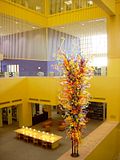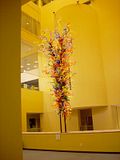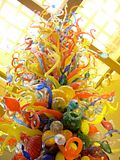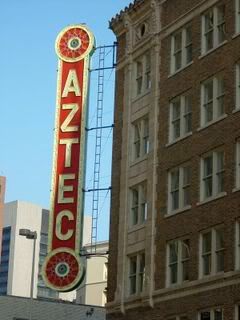
I met Dar at the Aztec Theater. She was there with Adam, a volunteer who is helping to promote the SAL Film Festival. We were waiting on Bryan and Druck. They were going to play a rough edit of Dr. S on the Aztec’s system. One of the managers of the Aztec took us into the theater proper. I wasn’t aware that you could enter from the ground floor of the lobby. The only other time I had been to the Aztec (during the San Antonio Underground Film Festival), the audience entered from the mezzanine level. I thought the lower part was sealed off. But no. This is where the the organ sits, as well as all sorts of kitschy faux Aztec details, such as a gigantic circular meso american calendar which hangs over some sort of alter or something. I gather dry ice fog, or something along those lines, comes out of the floor. I can dig it.

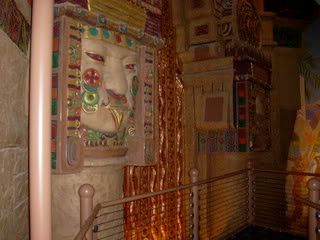
When Bryan and Druck showed up, we went into the projection booth. All the Aztec crew were wonderful.
I got to see about three quarters of Doctor “S” Battles the Sex Crazed Reefer Zombies. It’s still a very rough cut. I was glad to see it. Filmmakers are rarely privileged to see their colleagues works in such raw states. It’s a shame, really. I learned a lot watching Bryan’s early edit. I consider him to be a very accomplished and wildly talented filmmaker. And I was able to glean an idea as to how he shoots, edits, and plans out his work.
There is still shit loads of work to be done. But I’m convinced Bryan will get it all done. I just can’t see that he’ll have any time to sleep. It’s damn impressive to push a feature through post production at this rate. But it’s shaping up very well. Funny, quirky, and damn stylish. Even if you are a zombie film bigot, such as myself, there is one comically gory scene that will have you choking on your Good & Plenty, but in a good way.
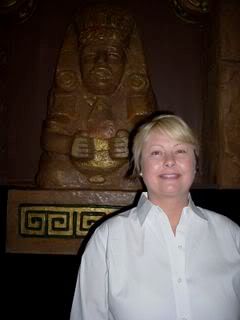
It’s shaping up into a wonderful event. I’ve been listening to Dar talk about this thing for quite awhile. A year at least. I am so proud of what she has been able to do, practically all on her own.
And for all you assholes who are thinking about NOT showing up, I feel someone should remind you: free beer and wine.
@@@@@@@@@@
The San Antonio Public Library (my branch, at least) no longer stamps their books. They give you a printed receipt, just like at the 7-11. I don’t care for this. What’s the problem? The price of ink pads are skyrocketing or something? So, I checked out three books. And tucked in one of them was a receipt that, when you read the fine print, would tell you when it was due.
I had to go downtown and pay $3.50 for overdue books. What a racket.
However, I decided to take my camera in and shoot a few snaps of the Chihuly sculpture. I’m not really a big fan of Dale Chihuly, but I always smile when I see his work — especially these sorts of larger installations.
I love almost everything about the downtown San Antonio public library. The playful postmodern architecture, the garish color scheme (referred to by the locals as the “enchilada building”), the meandering water sculpture, the grand central enclosed atrium, the upward flowing Chachuly piece — now if they could just allocate some funds for books and media.
(Click on the tumbnails for bigger images.)
I checked out three DVDs. This afternoon I watched one of them. Robert Anton Wilson: Maybe Logic. It’s a series of interviews with Wilson, interspersed with some of his lectures, as well as bits with his colleagues and friends. It was finished in, I believe, 2002. Many of the clips were of Wilson very infirmed, as his post polio syndrome began to lay him low — yet he never slipped into pessimism or self pity. It’s a bittersweet portrait of a major counter cultural icon.
@@@@@@@@@@@
Late in the afternoon I printed up eleven copies of a two page prose piece and headed off to the monthly Gemini Ink free writers work shop. This is the second months that we’ve had so many attendees that we had to break up into two groups.
Jim, who runs the workshops, decided to break the group in half by pointing to those who were seated at the right side of the crowded table. We were to go into another room, and share our work there. One of us was selected as the facilitator. I was okay with that, because Michael was in my group, and he’s one of my favorite writers who shows up at these things. The only other writer I was looking forward to seeing was Elizabeth. I’d heard her read once before. She’s working on a book which if it isn’t strictly speaking a young adult novel does indeed involve an adolescent as the central protagonist. But most important, she has a strong voice. Yes, she’s a very good writer, but there’s a lot of good writers out there. A clear, distinctive voice, however, is a rare thing indeed. She’s got that. But she wasn’t at the table.
We moved to the other room and rearranged the chairs and set up a table. There were seven of us. And like most of these events it was a mixed bag of good, bad, and indifferent. Michael read a poem which is embedded in one of his huge, brilliant unpublished novels. But I didn’t much care for it. It was a bit too technical. But a surprise was this guy who had never before attended. He read from a work in progress — essay, short story, novel? He’s not yet sure. I wish I had got his name. He’s an older guy. Maybe in his early sixties. Damn good writing. Damn good reading.
When we were heading out, I noticed that Elizabeth was sitting in the other room. I guess she came late. I waited around (the other group was larger than ours, and they ended a bit later).
I asked if she would give me a copy of what she had brought to read. She handed me a copy. And she asked for a copy of what I had read. We chatted for a while, and then headed out.
For those who are curious, I wimped out this time around. I started two stories which fit within my “fictional blog” cycle, but they really were sucking. So, I followed a path of lesser resistance. I turned to an old email (which, actually, was printed in this blog almost a year ago in a somewhat different fashion). With a few slight augmentations, I printed it up and read it to my group.
Below the break is that version.
@@@@@@@@@@@@@@@
Michelangelo Antonioni is Dead by Erik Bosse
Some of my clearest memories of my teen years were those spent in a darkened repertory cinema in walking distance from my home. There awaited me foreign films unlike anything that made it to my TV set. I’d drag my friends along, but they rarely accepted my invitations twice. They fidgeted in their seats as though they were waiting on the dentist. What they found tedious, I found thrilling.
Some of the devices that seem to have irked them were, in fact, simply innovative camera work. Such as a couple sitting at a cafe where the camera never leaves the tight shot of a cup of coffee as the dialogue unfolds. Ah, the economy of the visual language! Or, the opposite, where the characters engage in animated conversations about art or philosophy while moving quickly down the sidewalk, puffing aggressively on cigarettes. The camera rushes to keep up. The scene is disjointed with frantic jump cuts. Such energy and passion! Sadly, my friends yearned for stories of gigantic, ravenous sharks, or, even better, robots from a galaxy far, far away.
Why, I wondered, couldn’t they generate the same enthusiasm for a story about, say, a middle aged Italian man who paces in a hotel room, immaculate in slacks and a white shirt with tie? He flails about with a lit cigarette, hectoring an eighteen year old sex-pot wearing pajamas and sitting on the bed with her arms crossed in silent and accusing petulance. The man is probably wearing sunglasses, and he often stops in his tirade to momentarily preen in the hotel mirror. He will begin spanking the girl any minute now, but only after the camera has drifted its attention to the pigeon pecking about on the window ledge.
It was all sweet eye-candy to me. How about a picnic with young people? They are the slumming bourgeoisie, and are dressed accordingly: no suit coats or hats, ties loosened, cuffs unbuttoned. Women wear dresses and are barefoot — or maybe they have on tight black toreador pants and rumpled blouses. Turtlenecks and berets are always allowed. Cigarettes are items to hide behind, never enjoyed. Picnics must have wine and long loaves of crusty bread. Cheese and fresh fruit are allowable options.
Montages are the very life blood of these movies, and they can use any of the items already mentioned. Coffee, cigarettes, wine, etc. If there are quick shots of nature, the stamp of the modern industrial world should always be present: sparrows wash themselves in water pooled in a rut caused by a car tire; butterflies nose around the blossoms of a pear tree as a passenger plane roars across the sky; a field of barley undulates in the breeze, and the camera dollies left to reveal the mud-splattered Citroen, its rear bumper jacked up — a grimly petulant eighteen year old girl in tight black toreador pants changes a flat tire as her forty-year-old boyfriend leans against the front bumper sipping a cappuccino while in the back-seat the girl’s younger, effete brother lounges with his feet out the window while he smokes a cigarette and reads Balzac.
A misspent youth watching all these films invariably carves out a little realm in the brain where simulated versions of Truffaut, Antonioni, or Fellini can be cobbled together in real time in the mind’s own repertory cinema.
I fancy I can conjure up a short one right now.
We open with a tight shot of a masculine hand reaching across the cafe table to brush a fly off a pastry on a plate. Extreme close up of a single tear rolling down a young woman’s face. Oblique angle up at a church clock tower. Slow pan of birds splashing around in a fountain in the public square. Extremely tight shot of a masculine finger stroking the cigarette pack placed aside the pastry plate. Full shot in profile of a waiter at the back door of a cafe enjoying a cigarette — he’s deep in the shadows thrown by an adjacent building, but when he exhales, the smoke hits the sunlight as pure white. Wide low shot of the parish priest riding on his bicycle — he bounces over the cobblestones of the square and he rolls to a gentle stop beside two men sitting at a table near a fruit stand. Two-shot of the men looking up from their chess game. They smile at the camera (the priest). Tight shot of the priest smiling with boyish innocence. Two-shot of the men turning back to their game. Overhead shot of the chess board. A hand comes in and hovers, uncertain, over the white queen. Tight shot of the priest — shocked, he leans in slow and breathless. Tight shot on a pretty girl’s face. A pretty hand comes in and wipes a tear away. Tight shot of a masculine hand fishing a cigarette from the pack near the pastry. A pretty hand comes in and softly drapes over the man’s hand. Low tight shot of the church clock. Ten-thirty. It chimes once with a terrible reverberating clang. Medium shot of the fountain. The birds scatter in a panic. Extreme close up of a finger descending onto the white queen. It makes firm contact. Wide shot of the table near the fruit stand. One man stands and begins shouting. The priest crosses himself. Wide shot of the cafe table. The man stands abruptly, knocking over his chair. He snatches up his cigarettes and storms off. Close up of the girl. She’s gathered herself together now, with a sort of petulant resolve. She looks around toward the entrance of the cafe. “Garçon!” she shouts. Medium shot of the waiter at the back door. He looks at his cigarette. Tight shot of the cigarette. It’s just a little stub. Wide shot of the waiter. He tosses the cigarette to the ground and walks inside. Tight shot of the cigarette still smoldering on the ground next to a pile of garbage. A pigeon flutters in and begins pecking at a piece of pastry in the dirt next to the smoldering cigarette.
FINI
